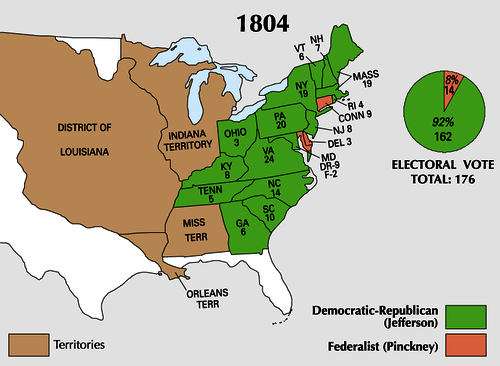United States presidential election, 1804
| | |||||||||||||||||||||||||||||||||||||||
| |||||||||||||||||||||||||||||||||||||||
| |||||||||||||||||||||||||||||||||||||||
|
| |||||||||||||||||||||||||||||||||||||||
| Presidential election results map. Green denotes states won by Jefferson, burnt orange denotes states won by Pinckney. Numbers indicate the number of electoral votes allotted to each state. | |||||||||||||||||||||||||||||||||||||||
| |||||||||||||||||||||||||||||||||||||||
The United States presidential election of 1804 was the fifth quadrennial presidential election, held from Friday, November 2, to Wednesday, December 5, 1804. It pitted incumbent Democratic-Republican President Thomas Jefferson against Federalist Charles Cotesworth Pinckney of South Carolina, a hero of the American Revolutionary War and former Ambassador to France. Jefferson easily defeated Pinckney and George Clinton was elected vice president. Clinton went on to serve under both Jefferson and his successor, James Madison.
The presidential election of 1804 was the first one conducted following the ratification of the Twelfth Amendment to the United States Constitution, which reformed procedures for electing presidents and vice presidents. Under the rules of the Twelfth Amendment, presidential electors were required to specify their choice for president and vice president on their ballots; previously, electors voted only for president, with the person who came in second becoming the vice president.
Jefferson's 45.6 percentage point victory margin in the popular vote remains the highest victory margin in a presidential election in which there were multiple major party candidates. With this election, Jefferson became the first former vice president in American history to be elected and reelected, a feat that has since been repeated only once, by Richard Nixon in 1968 and 1972.
Background
Although the presidential election of 1800 was a close one, Jefferson steadily gained popularity during his term. American trade boomed due to the temporary suspension of hostilities during the French Revolutionary Wars in Europe, and the Louisiana Purchase was heralded as a great achievement.
Nominations
Democratic-Republican Party nomination
The caucus of Republicans in Congress selected the ticket. Jefferson's re-nomination was never in any real doubt, with the real issue being seen as who would they would nominate to replace disgraced Vice President Aaron Burr. Burr would likely have been dropped from the ticket anyway since his relationship with Jefferson had soured, but the Burr–Hamilton duel definitively ended any hope of Burr's re-nomination. Governor George Clinton of New York was chosen to be Jefferson's running mate instead.
Presidential candidates
- Thomas Jefferson (Virginia), President of the United States
-

President
Thomas Jefferson
Vice-presidential candidates
- John Breckinridge (Kentucky), U.S. Senator
- George Clinton (New York), Governor
- Gideon Granger (Connecticut), Postmaster General
- John Langdon (New Hampshire), former U.S. Senator
- Levi Lincoln (Massachusetts), U.S. Attorney General
- William Maclay (Pennsylvania), former U.S. Senator
-

Senator
John Breckinridge
from Kentucky -
.jpg)
Governor
George Clinton
of New York -

Postmaster General
Gideon Granger -

Attorney General
Levi Lincoln
Balloting
| Presidential ballot | Total | Vice-presidential ballot | Total |
|---|---|---|---|
| Thomas Jefferson | 108 | George Clinton | 67 |
| John Breckinridge | 20 | ||
| Levi Lincoln | 9 | ||
| John Langdon | 7 | ||
| Gideon Granger | 4 | ||
| William Maclay | 1 |
Federalist Party nomination
The Federalists chose Pinckney and former United States Senator Rufus King of New York to run against Jefferson and Clinton.
Presidential candidates
Vice-presidential candidates
- Rufus King (New York), former U.S. Senator
General election
Attacks on Jefferson's policies proved fruitless; Jefferson's victory was overwhelming. He even won most of the states in the Federalist stronghold of New England. Pinckney won only two states- Connecticut and Delaware.
Results


| Presidential candidate | Party | Home state | Popular vote(a), (b) | Electoral vote |
Running mate | |||
|---|---|---|---|---|---|---|---|---|
| Count | Pct | Vice-presidential candidate | Home state | Elect. vote | ||||
| Thomas Jefferson (Incumbent) | Democratic-Republican | Virginia | 104,110 | 72.8% | 162 | George Clinton | New York | 162 |
| Charles C. Pinckney | Federalist | South Carolina | 38,919 | 27.2% | 14 | Rufus King | New York | 14 |
| Total | 143,029 | 100% | 176 | 176 | ||||
| Needed to win | 89 | 89 | ||||||
Source (popular vote): U.S. President National Vote. Our Campaigns. (February 10, 2006).
Source (Popular Vote): A New Nation Votes: American Election Returns 1787-1825[1]
Source (electoral vote): "Electoral College Box Scores 1789–1996". National Archives and Records Administration. Retrieved July 30, 2005.
(a) Only 11 of the 17 states chose electors by popular vote.
(b) Those states that did choose electors by popular vote had widely varying restrictions on suffrage via property requirements.
Electoral college selection
| Method of choosing electors | State(s) |
|---|---|
| Each elector appointed by state legislature | Connecticut Delaware Georgia New York South Carolina Vermont |
| Each elector chosen by voters statewide | New Hampshire New Jersey Ohio Pennsylvania Rhode Island Virginia |
| State is divided into electoral districts, with one elector chosen per district by the voters of that district | Kentucky Maryland North Carolina Tennessee |
|
Massachusetts |
See also
- Bibliography of Thomas Jefferson
- History of the United States (1789–1849)
- United States House of Representatives elections, 1804
- Second inauguration of Thomas Jefferson
References
- "A Historical Analysis of the Electoral College". The Green Papers. Retrieved March 20, 2005.
- A New Nation Votes: American Election Returns 1787-1825
- Presidential Election of 1804: A Resource Guide from the Library of Congress



